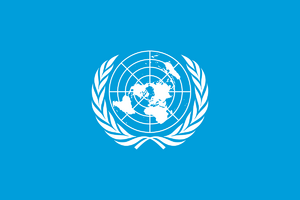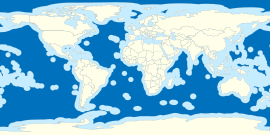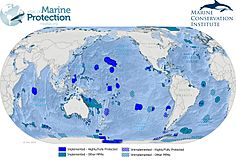High Seas Treaty facts for kids
 |
|
| Type | International legally binding instrument |
|---|---|
| Drafted | 4 March 2023 |
| Signed | Not yet |
The United Nations High Seas Treaty is a very important agreement. It helps protect and use the amazing variety of life in the ocean, especially in areas far from any country's coast. These areas are called "areas beyond national jurisdiction." This treaty is part of the United Nations Convention on the Law of the Sea (UNCLOS). It's also known as the Biodiversity Beyond National Jurisdiction treaty or the BBNJ treaty. The final text of this treaty was agreed upon at the UN on March 4, 2023.
The treaty focuses on four main topics:
- Marine genetic resources (MGRs): This includes how to share the benefits fairly from ocean life.
- Area-based management tools (ABMTs): These are ways to protect specific parts of the ocean, like marine protected areas (MPAs).
- Environmental impact assessments (EIAs): These check how human activities might affect the ocean.
- Capacity building and transfer of marine technology (CB&TMT): This helps countries learn and share tools to protect the ocean.
The parts about managing ocean areas and checking environmental impacts are mostly about protecting ocean life. The parts about marine genetic resources and sharing technology also deal with making things fair for all countries.
Before this treaty can start working, many countries need to officially agree to it. At least 60 UN member states must approve it. This process can take some time. For example, the older UNCLOS treaty was agreed in 1982 but only started working in 1994. Today, 167 countries and the European Union follow UNCLOS.
Both countries and groups of countries (like the European Union) can become part of this new treaty.
Contents
Why the High Seas Treaty is Needed

Our oceans are facing big problems. The variety of life (called biodiversity) is shrinking, and ocean environments are getting damaged. This is happening because of climate change and more human activities. Things like shipping, too much overfishing, plastic pollution, and deep-sea mining are causing harm.
Because of these threats, we need a better way to manage the ocean. The old rules are not strong enough to protect ocean life far from shore. The High Seas Treaty aims to fill these gaps.
Areas beyond national jurisdiction include the 'high seas' (the water itself) and the ‘area’ (the ocean floor). These make up about two-thirds of the entire ocean. Currently, different regional groups try to manage these areas. But they often only focus on specific things, like fishing. Also, they don't work together very well, and most of the ocean is left without clear rules.
The other one-third of the ocean is closer to land. It falls under national control, within what are called exclusive economic zones (EEZs). These zones stretch about 370 kilometers (200 nautical miles) from a country's coast. Countries have the right to manage the resources in these zones.
How the Treaty Was Negotiated
Discussions about a new agreement for areas beyond national control have been going on at the United Nations for almost 20 years! Meetings started in 2004 to prepare for this new treaty. On December 24, 2017, the United Nations General Assembly decided to hold official meetings to create this new international agreement.
From 2018 to 2023, diplomats met at the UN Headquarters in New York City. There were five main negotiation sessions.
During the first meeting in September 2018, countries seemed more focused on who controlled these "Beyond National Jurisdiction" areas than on protecting "Biodiversity" itself.
In the second meeting in March/April 2019, it became clear that a rule saying the new agreement "should not weaken" existing groups might make it hard to create a strong treaty.
The third meeting in August 2019 focused on two ideas: 'the freedom of the seas' (meaning anyone can use the ocean) versus 'the common heritage of mankind' (meaning the ocean belongs to everyone).
The fourth meeting was supposed to happen in 2020 but was delayed until March 2022 because of the COVID-19 pandemic. During this meeting, countries still disagreed on many important points.
The fifth meeting took place in August 2022. Good progress was made, but they couldn't agree on the final text. So, they paused the meeting and started it again in February/March 2023. After nearly two decades of work, the final text was finally agreed upon! Rena Lee, the president of the conference, announced the agreement with the words, “the ship has reached the shore.” A final meeting was held in June 2023 to officially adopt the agreement.
What the Treaty Covers
Protecting Ocean Life: Marine Genetic Resources
Marine genetic resources (MGRs) are the first important part of the treaty. These are like the "building blocks" of ocean life. They can be used to create new things like ingredients for cosmetics, pharmaceuticals (medicines), and food supplements. We don't know their full economic value yet, but many groups are very interested in finding and using them.
During the UN talks, there was a big debate about whether MGRs should include 'fish' and 'fishing activities'. Some experts said that fish are a huge part of ocean life and important for ocean health. However, the final treaty says that the rules about marine genetic resources do not apply to 'fish' and 'fishing' in areas far from national control.
Sharing the benefits from these resources fairly was also a tricky point. In the end, they agreed to share both money and other benefits. A special committee will be set up to make sure this sharing is done in a clear, fair, and equal way.
Protecting Ocean Life: Marine Protected Areas
Area-based management tools (ABMTs), including marine protected areas (MPAs), are super important for protecting and bringing back ocean life. They can be used to keep certain parts of the ocean safe. MPAs offer long-term protection and some already exist. However, they cover only a small part of the ocean far from shore. ABMTs can also be used for shorter-term protection or to deal with specific problems.
Here's how a new protected area or tool is set up:
- First, a country that is part of the treaty suggests a new area or tool.
- This suggestion must be based on the best science available.
- The idea is shared publicly and reviewed by a group of scientists and experts.
- Then, people who might be affected are asked for their opinions.
- The decision to create the area must be agreed upon by everyone, if possible. If not, three-quarters of the countries present and voting must agree.
- The decision becomes official after 120 days. It will be binding for all countries in the treaty. However, if a country objects within those 120 days, they might be able to opt out.
After the treaty text was finished, some reports said it would protect 30% of the oceans by 2030. This "30 by 30" goal was set at the UN Biodiversity Conference (COP15) in December 2022. Experts say the treaty can help reach this goal, but countries will need to take a lot more action.
Checking for Harm: Environmental Impact Assessments
Environmental impact assessments (EIAs) help us guess, reduce, and stop human activities from harming ocean life and environments. While rules for EIAs are strong close to shore, they are not as developed in areas far away. Under this treaty, countries must do EIAs if a planned activity might affect the ocean, or if we don't know enough about its possible effects. The country in charge of the activity must do the assessment.
The treaty also talks about Strategic Environmental Assessments (SEAs). These are broader checks that look at long-term environmental protection for plans and programs. Countries should consider doing SEAs for their activities in areas beyond national control, but they are not forced to.
Sharing Knowledge: Capacity Building and Technology Transfer
Capacity building and the transfer of marine technology are about making sure everyone can access research done in international waters. They also help countries work together and take part in the treaty's activities. The agreement mentions different ways to do this, such as:
- Sharing information and research results.
- Creating and sharing guides and standards.
- Working together on ocean science.
- Helping countries build their own skills and rules.
Technology is very important for making the treaty work. So, helping countries learn and share technology is key to enforcing it. A main goal is to support developing countries and those that don't have easy access to the ocean.
A special committee will be set up to watch and review these efforts.
How the Treaty Will Be Managed
The treaty creates a new system to manage itself. This includes:
The Conference of the Parties (COP) This is like the main meeting for all countries in the treaty. Their first meeting will be within a year after the treaty officially starts. They will decide on the rules for how they work and how money will be handled. The COP will check how the High Seas Treaty is being put into action. They will make decisions by everyone agreeing (consensus) or, if that's not possible, by two-thirds of the countries voting yes. The COP will also make sure everything is clear and open. Five years after the treaty starts, the COP will review it.
The Scientific and Technical Body This group will be made of experts chosen by the countries in the treaty. They will give scientific and technical advice to the Conference of the Parties. They will also watch and review the ocean protection areas and comment on environmental impact assessments.
The Secretariat This is the team that provides support. They help the Conference of the Parties and its groups by arranging meetings and sharing information about the treaty.
The Clearing-House Mechanism This will be an open online platform. It will make it easier to find, share, and spread information. It will help make things clear and encourage countries to work together. The Secretariat will manage this platform.
The treaty also sets up other committees, like one for sharing benefits and another for financial resources.


